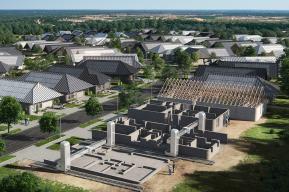文章
气候变化引发了对冲突的关切

全球变暖对世界自然景观的影响,常常导致地缘政治变化,有可能破坏非洲之角等原本脆弱区域的稳定。自然资源承受的压力削弱了各国的自我治理能力,增加了冲突的可能。与国际安全风险的其他驱动因素相比,气候变化模型可以具有较高的确定性。但是在预测和准备之间,仍有漫漫长路要走。
凯特琳·E·沃雷尔、弗朗西斯科·费米亚
当前气候急剧变化,海平面升高、北极冰层减少、冰川融化、降雨量变化莫测,以及暴风雨频繁,这是人类社会进入定居时代以后从未经历过的情景。这些动态将影响人民、国家和建立在国家之上的世界秩序存续、安全和繁荣所依赖的基本资源,特别是食物和水。这些影响已经加剧了世界关键区域国家的脆弱性和安全问题——中东和非洲的冲突,南中国海渔业问题造成的紧张,以及冰雪正在消融的北冰洋上开辟的政治经济战场。
气候变化正在改变世界自然景观,也正在改变世界的地缘政治格局。如果各国政府不能减缓这种情况,冲突和动荡的风险将会增加,变得更加难以管理,全球很多地区都处于这种情况下。但是,非洲之角因为结构脆弱,又容易遭受气候变化风险,所以尤其岌岌可危。这加剧了半岛冲突和动荡的可能。
脆弱的中心
一个时期以来,自然资源承受的气候变化压力,加上所承受的人口、经济和政治压力,可能会削弱国家的自我治理能力。这种能力包括国家满足国民对粮食、水、能源和就业等基本资源需求的能力,也称为国家的产出合法性。产出合法性面对的威胁,可能会导致国家更脆弱,加剧内部冲突,甚至促使国家崩溃。从这个角度来看,气候变化对非洲之角国家的稳定和合法性构成严峻挑战,该区域在气候变化成为一个影响因素之前,已经在奋力应对诸多挑战。
2018年1月,联合国安全理事会主席发表声明,已经确认了这些挑战:“安全理事会确认气候变化和生态变化等因素对西非和萨赫勒区域稳定造成的不利影响,包括干旱、荒漠化、土地退化和粮食短缺,并强调各国政府和联合国需要针对这些因素进行充分的风险评估并制定有关风险管理战略。”
根据和平基金会的脆弱国家指数,非洲之角囊括了一些全世界最脆弱的国家——索马里、埃塞俄比亚、厄立特里亚、肯尼亚、苏丹和南苏丹。该区域还呈现一些迹象,极为清楚地表明气候变化和冲突之间的关联,即气候加剧了干旱和水情变化,继而导致农业社区和游牧社区之间发生冲突(更多信息请参阅:《美国农业经济学期刊》,第96卷,第4期,2014年7月1日,第1157-1182页)。
例如,因气候恶化导致长期极端干旱, 2011年发生在索马里的干旱,给早已紧张和资源匮乏的境况增添了压力。这些压力有可能加剧社区间的紧张和冲突,迫使人们不得不迁移,从而影响牲畜和其他商品的价格。这还可能导致营养不良和疾病暴发的持续增加,并对粮食安全产生不利影响。
当地为获取食物和水资源而产生的紧张,可能蔓延到邻国,因为人们都极力寻求更多资源和更大安全,这对这些国家的资源造成更多压力,有可能会加剧紧张局势。在这些情况下,气候变化不会直接“导致”水供给减少的冲突,却使相关自然资源承受的压力倍增,增加了冲突的机会。如果不实施更好的治理和自然资源管理手段,这些情况在不久的将来会越来越明显。
变化中的地缘政治格局
结合模型和展望的若干项研究越来越准确地显示出,气候条件的变化如果得不到缓解,将会上升到更高层次的安全局势,包括冲突的可能性加大。不过,到目前为止,很多研究都集中在探索气候变化、降雨变异性增加和冲突之间的联系。气候影响和安全相交叠,并共同构成新地缘政治格局基础的其他情景包括以下五个方面:
‣ 海平面上升与沿海城市
非洲之角,包括沿海地区,正在快速实现城市化。人口正在急剧增长的沿海城市,例如摩加迪沙(索马里)、吉布提和蒙巴萨(肯尼亚),容易受海平面上升的影响。海平面不断上升带来的威胁是淹没城市内的重要基础设施。海水入侵还可能污染淡水供应,减少可耕土地,造成大量人口流离失所。
‣ 危险的海上航道
亚丁湾是非洲之角沿岸的重要航道。随着气候变化进一步减少该地区的经济机会,沿海海盗活动可能会变得更加猖獗,特别是在亚丁湾和曼德布海峡。实际上,有研究表明,海盗袭击高发的国家(索马里和厄立特里亚沿海)和非洲气候最脆弱地区之间存在明显重叠。这勾画出一幅令人忧心的图景,即各种风险相互叠加,可能使非洲之角国家一蹶不振。
‣ 鱼类和粮食安全
海洋酸化和变暖导致全世界,包括非洲之角沿岸鱼类种群的迁移和灭绝,尽管该区域缺乏广泛的监测意味着对其影响程度的了解存在差距。不断变化的海洋化学成分和温度,使同一条海岸线沿线的非洲之角国家和次国家行为体之间出现国际紧张的可能性增加,包括因渔业而发生冲突的可能性增大,因为它们各自的渔船驶入邻近水域或者在公海争相捕捞日益减少的鱼群。
‣ 移徙
干旱,再加上其他因素,已经日益迫使非洲和其他地方的人口背井离乡。那些没有能力迁移的人,也有“陷入困境”的危险,或者无法迁移到更安全的地方。未来,非洲之角的降水量减少,极端天气事件增多,很可能会增加移徙的速度和规模。据加拿大维尔弗雷德·劳里埃大学的罗伯特·麦克莱曼(Robert McLeman)称:“政治上已经很脆弱的国家,将来最有可能成为与气候有关的暴力和被迫移徙事件的中心。”(《气候和安全的中心》,2017年)实际上,在2017年脆弱国家指数排名最高的20个国家中,有12个位于中东、南亚和非洲地区,预计这些地区的气候变化将加剧水资源短缺。这包括五个非洲之角国家:厄立特里亚、肯尼亚、索马里、南苏丹和苏丹。
‣ 水资源武器化
水资源供给的变化,包括气候变化加剧了水资源的稀缺性和可获得性,也为国家和非国家行为体利用水资源作为武器提供了机会。美国乔治·华盛顿大学的马库斯·金(Marcus King)最近的一项研究,讨论了索马里为何特别容易受到气候、冲突和水资源武器化的影响(《气候和安全的中心》,2017年)。2011年,索马里遭遇了与气候变化有关的区域性干旱,在此期间,正如金所指出的,原教旨主义“圣战”团体青年党改变了其传统游击战术,开始切断已获得解放的城市的水源,以显示至少拥有某种实力和存在。气候变化、食物短缺和涉及以水为武器的持续冲突,造成巨大社会损失。由于青年党的行动,人道主义机构提供援助的渠道不畅,导致25万多人死亡和数十万人流离失所。
一线光明
虽然干旱和极端天气事件在这一区域屡见不鲜,但是变化速度加快和极端天气事件之间的恢复期缩短,将使本已捉襟见肘的政府承受更多压力。这些动态将使国家动荡和冲突更易于发生,也更持久。不过,也有一线光明——气候变化,特别是与驱动国际安全风险的其他因素相比,建模确定性会相对较高。
虽然预测局部气候变化仍然存在很大的不确定性,但是基于气候模型的现有预测却为将来的情况勾画出了一幅相当清晰的图景。这为各国政府和社会作出相应规划奠定了基础。但是,预测能力的提高,本身并不能使人有所准备。“前所未有的风险”和“前所未有的展望”相结合,凸显了“有责任做好准备”(“对联合国安全理事会的通报”,2017年12月),次国家、国家和政府间机构有责任将气候复原能力纳入非洲之角的区域秩序建设中。如果不履行这一责任,就有可能给非洲之角乃至全世界的区域稳定造成巨大压力。
延伸阅读
By Caitlin E. Werrell and Francesco Femia
The current rate of climate change – higher seas, decreased ice in the Arctic, melting glaciers, extreme rainfall variability, and more frequent and intense storms – are scenarios that settled human societies have never experienced before. These dynamics will impact the foundational resources that people, nations – and the world order built on those nations – depend on for survival, security and prosperity: particularly food and water. These impacts are already contributing to increased state fragility and security problems in key regions around the world – conflict in the Middle East and Africa, tensions over fisheries in the South China Sea, and a new political and economic battleground in a melting Arctic Ocean.
Climate change, by altering the world’s physical landscape, is also changing its geopolitical landscape. If governments are unable to mitigate this, the risks of conflict and instability will increase, and become more difficult to manage. This is the case in many regions around the globe. However, the Horn of Africa is particularly vulnerable, given a combination of structural fragilities and the significant exposure to climate change risks. This raises the likelihood of conflict and instability on the peninsula.
A fragile epicentre
Over time, climate change stresses on natural resources – combined with demographic, economic and political pressures on those resources – can degrade a nation’s capacity to govern itself. This includes its ability to meet its citizens’ demands for basic resources – like food, water, energy and employment – also known as its output legitimacy. The threat to output legitimacy can contribute to state fragility, internal conflict, and even state collapse. Seen through this lens, climate change may present a serious challenge to state stability and legitimacy in the Horn of Africa – a region already grappling with numerous challenges before climate change became a factor.
These challenges have recently been confirmed by the United Nations Security Council in a January 2018 Statement by its President: “The Security Council recognises the adverse effects of climate change and ecological changes among other factors on the stability of West Africa and the Sahel region, including through drought, desertification, land degradation and food insecurity, and emphasizes the need for adequate risk assessments and risk management strategies by governments and the United Nations relating to these factors.”
According to the Fragile States Index of The Fund for Peace, the Horn of Africa includes some of the most vulnerable states in the world – Somalia, Ethiopia, Eritrea, Kenya, Sudan and South Sudan. The region also exhibits some of the clearest indications of a connection between climate change and conflict – namely, conflicts between agricultural and pastoral communities precipitated by climate-exacerbated droughts and water variability.
For example, prolonged climate-exacerbated extreme drought, such as in Somalia in 2011, can add additional stresses to already tense and resource-scarce scenarios. These stresses could increase tensions and conflict between communities, and precipitate the need for people to move – impacting the prices of livestock and other goods. This could also lead to an increase in malnutrition and disease outbreaks, and adversely impact food security (For more information, see: American Journal of Agricultural Economics, Volume 96, Issue 4, 1 July 2014, pp. 1157–1182).
Local tensions over access to food and water resources can spill over into neighbouring countries, as people seek to find additional resources and safety – placing more strain on the resources of those countries, which could amplify tensions. In these instances, climate change does not directly cause conflict over diminishing access to water, for example, but it multiplies underlying natural-resource stresses, increasing chances of a conflict. These are scenarios that, in the absence of better governance and natural resource management, are going to become increasingly pronounced in the future.
Changing geopolitical landscape
Several studies, combined with models and foresight exercises, show with increasing accuracy, the way in which changes in climatic conditions can, if left unmitigated, scale up to higher-order security situations, including a higher likelihood of conflict. A lot of the research to this point, however, has focused on the links between climate change, increased rainfall variability, and conflict. Other scenarios in which climate impacts and security intersect and combine to form the foundation of a new geopolitical landscape include:
‣ Sea-level rise and coastal cities
Urbanization is occurring rapidly in the Horn of Africa, including along the coast. Coastal cities with burgeoning populations, like Mogadishu (Somalia), Djibouti City and Mombasa (Kenya) are vulnerable to sea-level rise. Rising sea levels threaten to inundate critical infrastructure in these cities, contaminate freshwater supplies through saltwater intrusion, reduce arable land, and potentially displace large numbers of people.
‣ Dangerous seaways
The Gulf of Aden is a critical waterway along the Horn of Africa. As climate change further narrows economic opportunities in the region, an even greater increase of piracy along the coast is likely. Indeed, research has shown that there is a significant overlap between countries showing a high incidence of piracy attacks (off the coasts of Somalia and Eritrea), and the most significant climate vulnerability in Africa. This paints a worrying picture of the kinds of overlapping risks that can perpetuate state failure in the Horn.
‣ Fish and food security
Ocean acidification and warming are contributing to the migration and depletion of fish stocks around the world, including along the coast of the Horn of Africa – though the lack of extensive monitoring in this region means there is a gap in the knowledge of the extent of the impacts. Changing ocean chemistry and temperatures can increase the likelihood of international tensions between countries and subnational actors of the Horn that share a coastline – including a heightened potential for conflict over fishing, as their respective fishing fleets roam into neighbouring waters, or compete over dwindling stocks in international waters.
‣ Migration
Droughts, coupled with other factors, are already increasing pressure on people in Africa and elsewhere to move. Those without the means to move also risk becoming “trapped”, or unable to move to more secure locations. In the future, decreases in precipitation in the Horn, and increases in extreme weather events, will likely increase the rate and scale of migration. According to Robert McLeman of Canada’s Wilfrid Laurier University: “States that are already politically fragile are the most likely future epicenters for climate-related violence and forced migration events” (Epicenters of Climate and Security, June 2017). Indeed, of the twenty highest-ranked countries that are deemed fragile states, twelve are situated in areas of the Middle East, South Asia, and Africa, where climate change is expected to create heightened levels of water scarcity. That includes five countries of the Horn: Eritrea, Kenya, Somalia, South Sudan and Sudan.
‣ Water weaponization
Changes in water availability, including increased scarcity of, and access to, water exacerbated by a changing climate, also open up opportunities for states and non-state actors to use water as a weapon. In a recent study by Marcus King of George Washington University, United States, discusses how Somalia has been especially prone to this nexus of climate, conflict and water weaponization (Epicenters of Climate and Security, June 2017). In 2011, Somalia was hit by regional droughts that have been linked to climate change. During this time, as King notes, jihadist fundamentalist group “Al-Shabaab changed its traditional guerilla tactics and started to cut off liberated cities from their water sources so that they could demonstrate at least some kind of power and presence. Climate change, lack of food and continued conflict involving water weaponization took an enormous social toll. Limited access of humanitarian agencies exacerbated by al-Shabaab’s actions led to more than a quarter million deaths and hundreds of thousands of displaced persons.”
A small silver lining
While droughts and extreme weather events are not new to this region, the rate of change and the decrease in recovery time between extreme weather events will place additional pressures on governments already stretched thin. These dynamics can make state instability and conflict more likely and enduring. However, there is a small silver lining – climate change, especially when compared to other drivers of international security risks, can be modelled with a relatively high degree of certainty.
While significant uncertainties in predicting local-scale climatic changes remain, existing projections from climate models paint a fairly clear picture of what the future holds. This provides a basis for governments and societies to plan accordingly. However, this heightened predictive capacity does not, by itself, lead to preparedness. The combination of “unprecedented risk” and “unprecedented foresight” underlines the case for a “Responsibility to Prepare” (Briefing to the UN Security Council, December 2017) – a responsibility of sub-national, national, and intergovernmental institutions to build climate resilience into the Horn of Africa’s regional order. A failure to meet this responsibility could significantly strain regional stability in the Horn, and around the world.
Caitlin E. Werrell and Francesco Femia
Co-founders and presidents (United States) of the Center for Climate and Security, the Washington DC-based, non-partisan policy centre, which has a team and an Advisory Board of distinguished security and military experts. It is the only institution exclusively focused on the security risks of climate change.







